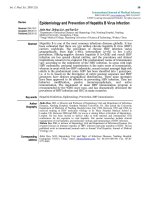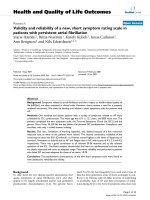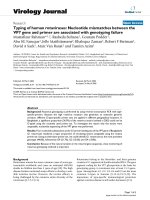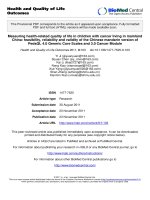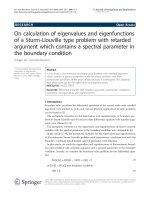Epidemiology and outcomes of children with renal failure in the pediatric ward of a tertiary hospital in Cameroon
Bạn đang xem bản rút gọn của tài liệu. Xem và tải ngay bản đầy đủ của tài liệu tại đây (372.12 KB, 7 trang )
Halle et al. BMC Pediatrics (2017) 17:202
DOI 10.1186/s12887-017-0955-0
RESEARCH ARTICLE
Open Access
Epidemiology and outcomes of children
with renal failure in the pediatric ward of a
tertiary hospital in Cameroon
Marie Patrice Halle1,2*, Carine Tsou Lapsap3, Esther Barla4, Hermine Fouda2,5, Hilaire Djantio6,
Beatrice Kaptue Moudze7, Christophe Adjahoung Akazong4 and Eugene Belley Priso5,8
Abstract
Background: Pediatric nephrology is challenging in developing countries and data on the burden of kidney
disease in children is difficult to estimate due to absence of renal registries. We aimed to describe the
epidemiology and outcomes of children with renal failure in Cameroon.
Methods: We retrospectively reviewed 103 medical records of children from 0 to 17 years with renal failure
admitted in the Pediatric ward of the Douala General Hospital from 2004 to 2013. Renal failure referred to either
acute kidney injury (AKI) or Stage 3–5 chronic kidney disease (CKD). AKI was defined and graded using either the
modified RIFLE criteria or the Pediatrics RIFLE criteria, while CKD was graded using the KDIGO criteria. Outcomes of
interest were need and access to dialysis and in-hospital mortality. For patients with AKI renal recovery was
evaluated at 3 months.
Results: Median age was 84 months (1QR:15–144) with 62.1% males. Frequent clinical symptoms were asthenia,
anorexia, 68.8% of participants had anuria. AKI accounted for 84.5% (n = 87) and CKD for 15.5% (n = 16). Chronic
glomerulonephritis (9/16) and urologic malformations (7/16) were the causes of CKD and 81.3% were at stage 5. In
the AKI subgroup, 86.2% were in stage F, with acute tubular necrosis (n = 50) and pre-renal AKI (n = 31) being the
most frequent mechanisms. Sepsis, severe malaria, hypovolemia and herbal concoction were the main etiologies.
Eight of 14 (57%) patients with CKD, and 27 of 40 (67.5%) with AKI who required dialysis, accessed it. In-hospital
mortality was 50.7% for AKI and 50% for CKD. Of the 25 patients in the AKI group with available data at 3 months,
renal recovery was complete in 22, partial in one and 2 were dialysis dependent. Factors associated to mortality
were young age (p = 0.001), presence of a coma (p = 0.021), use of herbal concoction (p = 0.024) and acute
pulmonary edema (p = 0.011).
Conclusion: Renal failure is severe and carries a high mortality in hospitalized children in Cameroon. Limited access
to dialysis and lack of specialized paediatric nephrology services may explain this dismal picture.
Keywords: Epidemiology, Outcome, Renal failure, Pediatric, Cameroon
* Correspondence:
1
Faculty of medicine and pharmaceutical sciences, University of Douala,
Douala, Cameroon
2
Department of internal medicine, Douala general hospital Cameroon, PO
Box: 4856, Douala, Cameroon
Full list of author information is available at the end of the article
© The Author(s). 2017 Open Access This article is distributed under the terms of the Creative Commons Attribution 4.0
International License ( which permits unrestricted use, distribution, and
reproduction in any medium, provided you give appropriate credit to the original author(s) and the source, provide a link to
the Creative Commons license, and indicate if changes were made. The Creative Commons Public Domain Dedication waiver
( applies to the data made available in this article, unless otherwise stated.
Halle et al. BMC Pediatrics (2017) 17:202
Background
Pediatric nephrology is very challenging and is not a priority in developing countries contrary to developed one [1].
Renal disease in children is common with increase prevalence of chronic kidney disease (CKD) globally and an annual incidence rate of 8% [2–5]. In addition, acute renal
failure, now call acute kidney injury (AKI), is common in
children admitted to hospitals, with a pooled incidence estimated at 33.7% [6]. The burden of kidney disease in children in most developing countries including Sub-Saharan
Africa (SSA) is unknown and difficult to estimate due to
lack of data on pediatric kidney disease and absence of
renal registries in general. Few hospital based studies exist
and the reported pattern of renal disease in pediatric
population is variable [7–13]. In developing countries the
major causes of CKD in children are chronic glomerulonephritis, urologic malformations (posterior urethral
valves) and CKD of unknown etiology, while for AKI
septicemia, diarrhea, malaria, and hemolytic uremic syndrome are the most frequent causes [13–20].
In Africa and in SSA especially, lack of advanced diagnostic infrastructure treatment facilities, and human resources
often leads to inaccurate diagnosis and suboptimal treatment of children with renal diseases. A recent metaanalysis on the outcome of AKI in children in SSA reported
that most children presented with severe AKI, with high
need for dialysis (66% of them) compared to the pooled
world need for dialysis in AKI of 11% [6, 21]. The main reasons were late presentation to hospital, the cost of care, the
use of clinical criteria for diagnosis, which appear only at
an advanced stage of the disease. Consequently, morbidity
and mortality is especially high in SSA where access to dialysis is very limited. Dialysis is not available in all services
and only 64% of children with need of dialysis could receive
the therapy. Outcome of these children is therefore very
poor with a mortality rate estimated at 34%, much higher
than the world rates of 13.8% [6, 21–24].
In Cameroon a country in SSA, nephrology and
hemodialysis was expanded in the last decade but more
for adults. Pediatrics nephrology is not a priority and
the country count only two pediatric nephrologists.
General pediatricians manage children, and when necessary they called adult nephrologists for further
workup and treatment. Few data exist on the burden of
kidney disease amongst adults in Cameroon [25, 26]
but data on pediatric renal diseases are inexistent despite the presence of risk factors. We conducted this
study with the aim to report the epidemiological profile
and outcome of renal failure among hospitalized children in the main tertiary referral hospital of Cameroon
and highlighting the challenges of care. This basic data
may help health policy makers to plan measures that
can improve the condition of children and prevent the
disease.
Page 2 of 7
Methods
The study was carried out at the pediatric unit of the
Douala general hospital in the littoral region of
Cameroon. Douala general hospital is the main one of
two tertiary hospitals of the country and the referral
hospital for all patients with kidney disease in the region
of about 3 million inhabitants. The pediatrics unit has a
team of seven general pediatricians that provide care to
children mostly referred from others hospital; no nephrologist pediatrician is available and children with kidney
disease are followed up by general pediatrician and adult
nephrologists when necessary. Hemodialysis is the only
renal replacement therapy available in the country. Access to care in Cameroon is not free but rather by payment mostly out of pocket for the majority due to lack
of health insurance.
We retrospectively reviewed medical records of children from 0 to 17 years with renal failure admitted in
the pediatric ward from 2004 to 2013. On admission in
that ward, all children routinely have a complete full
blood count, malaria test, serum electrolytes, urea and
creatinine. In children with renal abnormalities on admission, kidney test are repeated as needed. An abdominal ultrasound is routinely done for all children with
renal impairment. Renal failure referred to either AKI or
Stage 3–5 CKD. AKI was defined using either the modified RIFLE criteria (2004–2007) as an absolute increase
or decrease of serum creatinine of at least 1.5, or estimated glomerular filtration rate (eGFR) of more than
25% from baseline (value on admission), or a reduction
in urine output of less than 0.5 ml/kg per hour for more
than 6 h [27], or using the Pediatrics RIFLE criteria
(2008–2012), as urine output,0.5 ml/kg/h for greater
than eight hours and /or an estimated creatinine clearance (eCCl) decrease of at least 25%; If previous eGFR
was unavailable a baseline eGFR of 100 ml/min/1.73 m2
was assumed [28].
The diagnosis of CKD was based on the eGFR lower than
60 ml/min/1.73 m2, in a patients with either previous abnormal creatinine value and/ or urine abnormalities for
more than 3 months, associated with one or more of the
following: risk factor for CKD (ex: past history of glomerular disease, urologic malformation) presence of bilateral
schrunken kidney, hypocalcemia, hyperphosphoremia. [29]
eGFR was determined with the Schwartz formula, using
height and serum creatinine [30, 31]. Data collected were:
socio demographic information such as age and gender,
clinical (temperature, signs and symptom related to renal
failure and primary disease, daily urine flow rate, primary
diagnosis, laboratory results (kidney test, full blood count)
and outcomes (the need and access to dialysis and inhospital mortality). For patients with AKI renal recovery
(decreased of serum creatinine on admission or increase
of e CCl) was evaluated at 3 months.
Halle et al. BMC Pediatrics (2017) 17:202
Definitions
Total renal recovery was considered when creatinine or
eGFR at 3 months returned to normal or to baseline
value for those with CKD. Partial recovery when serum
creatinine at 3 months decrease or eGFR increase from
the baseline value but did not return to normal and no
recovery when at 3 months serum creatinine increase or
eGFR decreased compared to admission values or if the
patient remain on hemodialysis.
The cause of AKI was taken as the major diagnosis
leading to AKI in the child. Sepsis was defined as the
presence a systemic inflammatory response (fever >38 °
C, high white cell count at presentation) an increased Creactive protein level due to suspected or proven infection (by positive culture or tissue stain) caused by any
pathogen or a clinical syndrome associated with a high
probability of infection [32]. Severe malaria was defined
as the presence of fever with presence of plasmodium
falciparum on peripheral blood film associated with one
or more organ dysfunction such as hypotension, coma,
need of ventilation, hematologic involvement. Diarrhea
was the passage of three or more loose stools per day.
Chronic glomerulonephritis was based either on a history
of a documented glomerular disease or the presence of a
glomerular syndrome on admission (proteinuria and/or
hematuria, hypertension with bilateral small kidney, decrease eGFR, in the absence of identifiable secondary
causes. Diagnosis of posterior urethral valves was made on
a history of documented urology malformation, and/or on
ultrasound scan and micturating cystourethrogram record.
Anuria was defined as urine output less than 1 ml/kg/day.
Statistical analysis
Data analysis was done with the aid of a software program
statistical package for social science (SPSS) version 20. Descriptive statistics used comprised percentages and mean
± standard deviation (SD) and median (IQR). Logistic regression was used to look for factors associated to death.
A p value <0.05 was considered statistically significant.
Results
A total of 103 patients’ records (62% males) were included. The median age was 84 months (IQR: 15–144).
The most frequent clinical symptoms were asthenia
(97.8%), anorexia (92.3%) oedema (38.8%) and vomiting
(37.8%). In total 68.8% (55/103) of participants had anuria.
(Table 1).
AKI accounted for 84.5% (n = 87) and 86.2% (75/87) were
in stage F, with acute tubular necrosis 57.5% (n = 50/87)
and pre-renal AKI 35.6% (n = 31/87) being the most frequent mechanisms (Table 2). Main etiologies of AKI were
sepsis 57.5% (50/87), severe malaria 21.8% (19/87), hypovolemia 16.1% (14/87) and herbal concoctions 6.9% (6/87)
(Table 3).
Page 3 of 7
Table 1 Clinical and biological characteristics of the study
population
Variables
Median age (months) (IQR)
84 (15–144)
Male gender n (%)
64 (62.1)
Herbal concoctions n (%)
24 (23.3)
Urine flow rate n = 80
Anuria n (%)
55 (68.8)
Oliguria n (%)
7 (8.8)
Conserved n (%)
18 (17.5)
Urine Dipstick (n = 76)
Proteinuria n (%)
1+
26 (34.2)
2+
18 (23.7)
3+
17 (22.4)
Hematuria n (%)
57 (75)
Leukocyturia n (%)
31 (40.8)
Clinical n (%)
Asthenia
91 (88.3)
Anorexia
85 (85.2)
Pallor
88 (85.4)
Edema
40 (38.8)
Vomiting
39 (37.9)
Dyspnoea
28 (27.2)
Diarrhoea
24 (23.3)
Coma
19 (18.4)
Obnubilation/drowsiness
16 (15.5)
Agitation
11(10.7)
Biology (Mean ± ET)
Urea
2.14 ± 1.38
Creatinine
77.36 ± 82.01
Hemoglobin
7.68 ± 2.42
Natremia
132.32 ± 16.29
Kaliemia
4.96 ± 1.46
CKD accounted for 15.5% (n = 16) and Stage 5 was the
most frequent (81.3%). (Table 2). Chronic glomerulonephritis (9/16) and urologic malformations (7/16)
mainly posterior urethral valves were the causes of CKD
(Table 4).
Eight of 14 (57.1%) patients with CKD, and 27 of 40
(67.5%) with AKI who required dialysis, accessed it. Reason for non-dialysis were lack of adapted equipment
(57.9%), early death (26.3%), lack of finances (10.5%) and
severe immunodepression (5.3%). Loss to follow up in
CKD group was 37.5% (6/16) and 20.7% (18/87) in AKI.
Of the 25 patients in the AKI group with available data
at 3 months, renal recovery was complete in 22 (88%),
Halle et al. BMC Pediatrics (2017) 17:202
Page 4 of 7
Table 2 Type, stage and mechanism of renal failure amongst
participants
Table 4 Etiologies of CKD
Variables
Posterior Urethral valves
7 (43.8)
Type of renal failure n (%)
Chronic Glomerulo nephritis
9 (56.2)
AKI
87 (84.5)
CKD
16 (15.5)
Stages of AKI n (%)
R
0 (0)
I
12 (13.8)
F
75 (86.2)
Stages of CKD n (%)
3
0 (0)
4
3 (18.8)
5
13 (81.3)
AKI mechanism n (%)
Acute tubular necrosis
50 (57.5)
Pre-renal
31 (35.6)
Glomerular
4 (4.6)
Vascular
2 (2.3)
CKD mechanism n (%)
Glomerular
9 (56.2)
Obstructive
7 (43.8)
partial in 1 (4%) and 2 (8%) were dialysis dependent. Inhospital mortality was 50.7% for AKI and 50% for CKD
(Table 5). Factors associated to mortality were age <
96 months, (p = 0.001), the presence of a coma (p =
0.021), the use of herbal concoction (p = 0.024) and the
presence of acute pulmonary oedema (p = 0.011).
(Table 6).
Discussion
This study describe for the first time the epidemiology
and outcomes of renal diseases in hospitalized children
in the main tertiary referral hospital in Cameroon. The
results show that children were mainly males, AKI
accounted for the majority. Patients presented with severe disease. Chronic glomerulonephritis and urologic
Table 3 Etiologies of AKI
Etiologies
N (%)
Sepsis
50 (57.5)
Severe malaria
Hypovolemia
19 (21.8)
14 (16,1)
Diarrhea
8
Hemorrage
3
Heart Failure
3
Herbal concortion
6 (6.9)
Glomerulonephritis
4 (4.6)
Etiologies
N (%)
malformations were the causes of CKD while for AKI
acute tubular necrosis and pre-renal AKI were the most
frequent mechanism, with sepsis, severe malaria and
herbal concoctions being the main etiologies. Almost
half of the patients with need of dialysis did not access
to the treatment mainly due to lack of adapted material,
early death and financial constraint. Half of the patients
died in the hospital, more than 1/4 of patients were lost
to follow up. Renal recovery at 3 months in the AKI
group was complete for the majority and two patients
were dialysis dependent.
In this study, male patients were predominant. This is
in accordance with other studies from developing countries and could be explained by the increased susceptibility of boys to renal disease and probably by some
discrimination against women as it has been reported in
SSA [18, 19, 21, 33, 34, 35]. Globally patients presented
with severe renal insufficiency independently of the type.
This presentation with severe disease has been reported
in others studies in low-income countries in general and
in SSA in particular [20, 21, 34, 36]. Possible reasons
are: lack of early diagnosis, inadequate management of
potential treatable risk factors, the silent evolution of
kidney disease making that patients look for hospital
only when the disease is manifested, and especially financial constraints that is a major concern in SSA where
the majority of people are poor, and medical care is out
of pocket payment [37].
The prevalence of CKD in this study was 15.5%
amongst hospitalized children. This high figure was reported in studies in developing countries such as Iran
(14.9%), in Jordan (17.3%) Nigeria (20.3%) [10, 38, 39].
In contrast, El Tigani et al. in Soudan [40] found a lower
prevalence of 4%. Chronic glomerulonephritis and urologic malformations mostly posterior urethral valves
were the mains etiologies of chronic renal failure in the
present study. Ibasdin et al. in Nigeria [41] had similar
findings. In most developing countries, chronic glomerulonephritis was the main etiology of CKD, with prevalence ranging from 30 to 60%. This could be due to the
high prevalence of bacterial and parasitic infections that
commonly affect the kidneys in developing countries
[18, 19, 42, 43]. In contrast, urologic malformation was
the main etiology in most western countries and the 3rd
leading cause in Soudan [5, 40, 44]. Posterior urethral
valve, a surgically treatable condition was the main
urologic malformation responsible for chronic renal failure, raising the problem of late diagnosis, inadequate
Halle et al. BMC Pediatrics (2017) 17:202
Page 5 of 7
Table 5 Outcome
Variables
Total
N = 103
AKI
N = 87
CKD
N = 16
P
Median hospital stay (IQ)
6 (2–12)
6 (1–12)
6.5 (2.25–11.25)
0.76
Dialysis indication
54 (56.8)
40 (45.9)
14 (87.5)
0.01
Dialysis done
35 (64.8)
27 (67.5)
8 (57.1)
0.49
11 (57.9)
8 (57.1)
3 (50)
1
Reasons for non dialysis
Lack of adapted equipment
Lack of funds
2 (10.5)
1 (7.1)
1 (16.7)
0.52
Uncontrolled immunodepression (HIV)
1 (5.3)
0 (0)
1(16.7)
0.30
Early death
5 (26.3)
5 (35.7)
1 (16.7)
0.61
Renal recovery at 3 months(n = 25)
Complete
22 (88)
Partial
1 (4)
No recovery
2 (8)
Renal recovery unknown
62 (71.2)
Lost to follow
18 (20.6)
Death
44 (50.6)
CKD outcome at 3 months
On dialysis
2 (12.5)
Lost to follow up
6 (37.5)
Death
8 (50)
Mortality
Median delay (days) (IQ)
52 (50.5)
44 (50.6)
8 (50)
0.96
2 (1–6)
2 (1–6)
3 (2–5.5)
0.23
management of these children and inability to afford for
the surgery. In this study, AKI was mainly due to sepsis,
severe malaria and hypovolemia. This is in accordance
with reported finding in SSA [20, 21, 34].
It is well known that access to renal replacement therapy (RRT) is very limited in SSA with a huge gap between
those who required and received [45, 46]. In the present
study an average of 62.2% of children who required dialysis, accessed it. This is in the range of the mean percent
access to dialysis for children in SSA [21, 47]. Main reasons for non-dialysis in this study were lack of adapted
dialysis material, early death due to late presentation, and
financial restriction. Similarly Olowu et al. identified the
same factors amongst children with renal failure in
Nigeria (24).
Table 6 Factors associated to death in the study population
(multivariate analysis)
Variables
aOR
CI: 95%
p
Age ≤ 96 months
6.18
2.20–17.34
0.001
Herbal concoctions
4.29
1.21–15.19
0.024
Coma
6.79
1.33–34.58
0.021
Acute pulmonary oedema
4.46
1.40–14.20
0.011
Mortality rate and loss of follow up of children in the
present study was high a situation already known in SSA
[21, 32, 47, 48]. Almost half of the children died during hospitalization independently of the renal failure
type. Compared to the pooled mortality rate of children in the world in general and in SSA in particular,
our mortality for AKI was higher but in contrary
lower for CKD [6, 21, 47]. This high mortality rate could
be explained by many factors such as: the severity of the
renal disease at presentation in the hospital, the impact of
the underlying disease, the lack of adequate infrastructure,
the financial constraints especially for those with end stage
renal disease requiring hemodialysis. It is known that the
cost of hemodialysis is unaffordable for most families in
SSA [18, 24, 37, 49–52]. Attention should be paid to all
these factors and the development of preventive nephrology in SSA is very important. This will reduce the morbidity and mortality of renal failure amongst children.
Our study has some limitations: the retrospective nature
in which accuracy of data collection can be doubted. All
the shortcoming of such a study design such as the absence standardization in the assessment of variables and
the issue of missing data or cases. Also because of lack of
diagnosis facilities (renal biopsies, genetic test), some disease may have underestimated in this study. Despite these
Halle et al. BMC Pediatrics (2017) 17:202
limitations this study report for the first time the epidemiology and outcome of renal failure amongst children in
Cameroon. This basic data give information that could
help health planners in future to improve the outcome of
children in our setting and to prevent the disease.
Conclusion
In conclusion, our data revealed that renal failure, especially AKI is common amongst children in Cameroon
and they presented to the hospital with severe disease.
Access to dialysis was limited by various factors and
mortality rate was very high. This study also showed the
challenges of the care of children with renal failure in a
resource limited setting, where pediatrics nephrologists
are almost inexistent. Implementation of health insurance, education of the population, and training of
pediatric nephrologist are measure that could improve
the outcome of these patients. More importantly is the
prevention and treatment of primary disease.
Abbreviation
AKI: Acut Kidney Injury; CKD: Chronic Kidney Disease; eGFR: estimated
Glomerular Filtration Rate; SSA: Sub Saharan Africa
Acknowledgments
Not applicable.
Funding
None.
Availability of data and materials
The datasets generated and/or analyzed during the current study are
available from the corresponding author on reasonable request.
Author’s contributions
MPH: Conception and design of the study, and writing of the manuscript.
CSL: Study conception, data collection and critical revision of the manuscript.
EB: Study design, acquisition of data, data supervision and interpretation. HF:
Supervision of data analysis and interpretation of data, critical revision of the
manuscript. DH: Data analysis, and interpretation. BKM: Acquisition of Data,
and supervision, Critical revision of the manuscript. CAA: Acquisition of data,
supervision of data collection, Critical revision of the manuscript. EBP; Study
conception and design and critical revision of the manuscript. All authors
read and approved the final manuscript.
Ethics approval and consent to participate
We obtained ethical approval from the ethical board of the Douala
University, and administrative authorization from the Douala General
Hospital. In addition, patient data were de-identified before collection.
Consent for publication
Not applicable.
Competing interests
The authors declare that they have no competing interests.
Publisher’s Note
Springer Nature remains neutral with regard to jurisdictional claims in
published maps and institutional affiliations.
Author details
1
Faculty of medicine and pharmaceutical sciences, University of Douala,
Douala, Cameroon. 2Department of internal medicine, Douala general
hospital Cameroon, PO Box: 4856, Douala, Cameroon. 3Faculty of medicine
and pharmaceutical science, University of Douala, Douala, Cameroon.
Page 6 of 7
4
Department of paediatric and neonatology, Douala general hospital, Douala,
Cameroon. 5Faculty of medicine and biomedical sciences, University of
Yaoundé I, Yaoundé, Cameroon. 6Higher Institute of Health Sciences,
Université des Montagnes, Bangangté, Bangangté, Cameroon. 7Departement
of pediatric and neonatology, Douala Laquintinie hospital; Higher Institute of
Health Sciences, Université des Montagnes, Bangangté, Cameroon.
8
Department of gynaecology, Douala general hospital Cameroon, Douala,
Cameroon.
Received: 4 April 2017 Accepted: 24 November 2017
References
1. Cochat P, Mourani C, Exantus J, Bourquia A, Martinez-Pico M, Adonis-Koffy L,
et al. Pediatric nephrology in developing countries. Medecine tropicale.
2009;69(6):543–7.
2. Alebiosu CO, Ayodele OE. The global burden of chronic kidney disease and
the way forward. Ethnicity & disease. 2005;15(3):418–23.
3. Ardissino G, Dacco V, Testa S, Bonaudo R, Claris-Appiani A, Taioli E, et al.
Epidemiology of chronic renal failure in children: data from the ItalKid
project. Pediatrics. 2003;111:e382–7.
4. Meguid El Nahas A, Bello AK. Chronic kidney disease: the global challenge.
Lancet. 2005;365(9456):331–40.
5. Van der Heijden BJ, van Dijk PC, Verrier-Jones K, Jager KJ, Briggs JD. Renal
replacement therapy in children: data from 12 registries in Europe. Pediatr
Nephrol. 2004;19(2):213–21.
6. Susantitaphong P, Cruz DN, Cerda J, Abulfaraj M, Alqahtani F, Koulouridis I,
et al. World incidence of AKI: a meta-analysis. Clinical journal of the
American Society of Nephrology : CJASN. 2013;8(9):1482–93.
7. Etuk IS, Anah MU, Ochighs SO, Eyong M. Pattern of paediatric renal disease
in inpatients in Calabar, Nigeria. Trop Dr. 2006;36(4):256.
8. Onifade EA. Ten-year review of childhood renal admissions into the Lagos
University teaching hospital, Nigeria. Nigerian Quarterly Journal of Hospital
Medicine. 2003;13(3–4):1–5.
9. Michael IO, Gabriel OE. Pattern of renal diseases in children in midwestern
zone of Nigeria. Saudi Journal of Kidney Diseases and Transplantation. 2003;
14(4):539.
10. Ocheke IE, Okolo SN, Bode-Thomas F, Agaba EI. Pattern of childhood renal
diseases in Jos, Nigeria: a preliminary report. Journal of Medicine in the
Tropics. 2010;12(2)
11. Bhatta N, Shrestha P, Budhathoki S, Kalakheti B, Poudel P, Sinha A, et al.
Profile of renal diseases in Nepalese children. 2008.
12. Kari JA. Pediatric renal diseases in the Kingdom of Saudi Arabia. World
journal of pediatrics : WJP. 2012;8(3):217–21.
13. Elzouki AY, Amin F, Jaiswal OP. Prevalence and pattern of renal disease in
eastern Libya. Arch Dis Child. 1983;58(2):106–9.
14. Assounga AG, Assambo-Kieli C, Mafoua A, Moyen G, Nzingoula S. Etiology
and outcome of acute renal failure in children in congo-brazzaville. Saudi
journal of kidney diseases and transplantation. 2000;11(1):40–3.
15. Bailey D, Phan V, Litalien C, Ducruet T, Mérouani A, Lacroix J, et al. Risk
factors of acute renal failure in critically ill children: a prospective descriptive
epidemiological study. Pediatr Crit Care Med. 2007;8(1):29–35.
16. Hui-Stickle S, Brewer ED, Goldstein SL, Pediatric ARF. Epidemiology at a
tertiary care center from 1999 to 2001. Am J Kidney Dis. 2005;45(1):96–101.
17. Van Biljon G. Causes, prognostic factors and treatment results of acute renal
failure in children treated in a tertiary hospital in South Africa. J Trop
Pediatr. 2008;54(4):233–7.
18. Anochie I, Eke F. Chronic renal failure in children: a report from Port
Harcourt, Nigeria (1985-2000). Pediatr Nephrol. 2003;18(7):692–5.
19. Rahman MH, Karim MA, Hoque E, Hossain MM. Chronic renal failure in
children. Mymensingh medical journal : MMJ. 2005;14(2):156–9.
20. Esezobor CI, Ladapo TA, Osinaike B, Lesi FEA. Paediatric acute kidney injury
in a tertiary hospital in Nigeria: prevalence, causes and mortality rate. PLoS
One. 2012;7(12):e51229.
21. Olowu WA, Niang A, Osafo C, Ashuntantang G, Arogundade FA, Porter J, et
al. Outcomes of acute kidney injury in children and adults in sub-Saharan
Africa: a systematic review. Lancet Glob Health. 2016;4(4):e242–e50.
22. Assounga AG, Assambo-Kieli C, Mafoua A, Moyen G, Nzingoula S. Etiology
and outcome of acute renal failure in children in Congo-Brazzaville. Saudi
Journal of Kidney Diseases and Transplantation. 2000;11(1):40.
Halle et al. BMC Pediatrics (2017) 17:202
23. Esezobor C, Oniyangi O, Eke F. Paediatric dialysis services in Nigeria:
availability, distribution and challenges. West Afr J Med. 2011;31(3):181–5.
24. Olowu WA. Renal failure in Nigerian children: factors limiting access to
dialysis. Pediatr Nephrol. 2003;18(12):1249–54.
25. Halle MP, Ashuntantang G, Kaze FF, Takongue C, Kengne A-P. Fatal
outcomes among patients on maintenance haemodialysis in sub-Saharan
Africa: a 10-year audit from the Douala general Hospital in Cameroon. BMC
Nephrol. 2016;17(1):165.
26. Halle MP, Takongue C, Kengne AP, Kaze FF, Ngu KB. Epidemiological profile
of patients with end stage renal disease in a referral hospital in Cameroon.
BMC Nephrol. 2015;16(1):59.
27. Bellomo R, Ronco C, Kellum J, Mehta R, Palevsky P. Acute renalfailure –
definition, outcomemeasures, animal models, fluidtherapy and information
technologyneeds: the second international consensus conference of the
acute DialysisQuality initiative (ADQI) group. Crit Care. 2004;8(4):R204–12.
28. Akcan-Arikan A, Zappitelli M, Loftis L, Washburn K, Jefferson L, Goldstein SL,
Modified RIFLE. Criteria in critically ill children with acute kidney injury.
Kidney Int. 2007;71(10):1028–35.
29. Kramer H. The national kidney foundation's kidney disease outcomes quality
initiative (KDOQI) grant initiative: moving clinical practice forward: WB
Saunders; 2010.
30. Hogg R, Furth S, Lemley K, Portman R, Schwartz G, Coresh J, et al. National
Kidney Foundation’s kidney disease outcomes quality initiative clinical practice
guidelines for chronic kidney disease in children and adolescents: evaluation,
classification, and stratification. Pediatrics. 2003;111(6 Pt 1):1416–21.
31. Schwartz GJ, Brion LP, Spitzer A. The use of plasma creatinine concentration
for estimating glomerular filtration rate in infants, children, and adolescents.
Pediatr Clin N Am. 1987;34(3):571–90.
32. Goldstein B, Giroir B, Randolph A. International consensus conference on
pediatric sepsis. International pediatric sepsis consensus conference:
definitions for sepsis and organ dysfunction in pediatrics. Pediatr Crit Care
Med. 2005;6(1):2–8.
33. Cerdá J, Bagga A, Kher V, Chakravarthi RM. The contrasting characteristics of
acute kidney injury in developed and developing countries. Nature clinical
practice. Nephrology. 2008;4(3):138–53.
34. Ladapo TA, Esezobor CI, Lesi FE. Pediatric kidney diseases in an African
country: prevalence, spectrum and outcome. Saudi Journal of Kidney
Diseases and Transplantation. 2014;25(5):1110.
35. Ulasi I. Gender bias in access to healthcare in Nigeria: a study of end-stage
renal disease. Trop Dr. 2008;38(1):50–2.
36. Halle MP, Kengne AP, Ashuntantang G. Referral of patients with kidney
impairment for specialist care in a developing country of sub-Saharan
Africa. Ren Fail. 2009;31(5):341–8.
37. Obiagwu PN, Abdu A. Peritoneal dialysis vs. haemodialysis in the
management of paediatric acute kidney injury in Kano, Nigeria: a cost
analysis. Tropical Med Int Health. 2015;20(1):2–7.
38. Derakhshan A, Al Hashemi GH, Fallahzadeh MH. Spectrum of in-patient
renal diseases in children "a report from southern part Islamic Republic of
Iran". Saudi Journal of Kidney Diseases and Transplantation. 2004;15(1):12.
39. Radi MA. Childhood renal disorders in Jordan. J Nephrol. 1995;8:162–6.
40. Ali E-TM, Rahman AH, Karrar ZA. Pattern and outcome of renal diseases in
hospitalized children in Khartoum state. Sudan Sudanese Journal of
Paediatrics. 2012;12(2):52.
41. Michael IO, Gabriel OE. Pattern of renal diseases in children in midwestern
zone of Nigeria. Saudi journal of kidney diseases and transplantation : an
official publication of the Saudi Center for Organ Transplantation, Saudi
Arabia. 2003;14(4):539–44.
42. Gulati S, Mittal S, Sharma RK, Gupta A. Etiology and outcome of chronic
renal failure in Indian children. Pediatr Nephrol. 1999;13(7):594–6.
43. Harambat J, Van Stralen KJ, Kim JJ, Tizard EJ. Epidemiology of chronic
kidney disease in children. Pediatr Nephrol. 2012;27(3):363–73.
44. Ehlayel M, Akl K. Childhood chronic renal failure in Qatar. The British journal
of clinical practice. 1991;46(1):19–20.
45. Anand S, Bitton A, Gaziano T. The gap between estimated incidence of
end-stage renal disease and use of therapy. PLoS One. 2013;8(8):e72860.
46. Liyanage T, Ninomiya T, Jha V, Neal B, Patrice HM, Okpechi I, et al.
Worldwide access to treatment for end-stage kidney disease: a systematic
review. Lancet. 2015;385(9981):1975–82.
47. Ashuntantang G, Osafo C, Olowu WA, Arogundade F, Niang A, Porter J, et
al. Outcomes in adults and children with end-stage kidney disease requiring
Page 7 of 7
48.
49.
50.
51.
52.
dialysis in sub-Saharan Africa: a systematic review. Lancet Glob Health. 2017;
5(4):e408–e17.
Bah A, Kaba M, Diallo M, Kake A, Balde M, Keita K, et al. Renal diseases–
morbidity and mortality in nephrology service, National Hospital Donka. Le
Mali medical. 2005;21(4):42–6.
Arogundade F, Sanusi A, Okunola O, Soyinka F, Ojo O, Akinsola A. Acute
renal failure (ARF) in developing countries: which factors actually influence
survival. The Central African journal of medicine. 2006;53(5–8):34–9.
Balaka B, Douti K, Gnazingbe E, Bakonde B, Agbere A, Kessie K. Etiologies et
pronostic de l’insuffisance rénale de l’enfant à l’hôpital universitaire de Lomé.
Journal de la Recherche Scientifique de l'Universite de Lome. 2012;14(1).
Chijioke A, Makusidi A, Rafiu M. Factors influencing hemodialysis and
outcome in severe acute renal failure from Ilorin, Nigeria. Saudi Journal of
Kidney Diseases and Transplantation. 2012;23(2):391.
Ponsar F, Tayler-Smith K, Philips M, Gerard S, Van Herp M, Reid T, et al. No cash,
no care: how user fees endanger health—lessons learnt regarding financial
barriers to healthcare services in Burundi, Sierra Leone, Democratic Republic of
Congo, Chad, Haiti and Mali. International Health. 2011;3(2):91–100.
Submit your next manuscript to BioMed Central
and we will help you at every step:
• We accept pre-submission inquiries
• Our selector tool helps you to find the most relevant journal
• We provide round the clock customer support
• Convenient online submission
• Thorough peer review
• Inclusion in PubMed and all major indexing services
• Maximum visibility for your research
Submit your manuscript at
www.biomedcentral.com/submit
